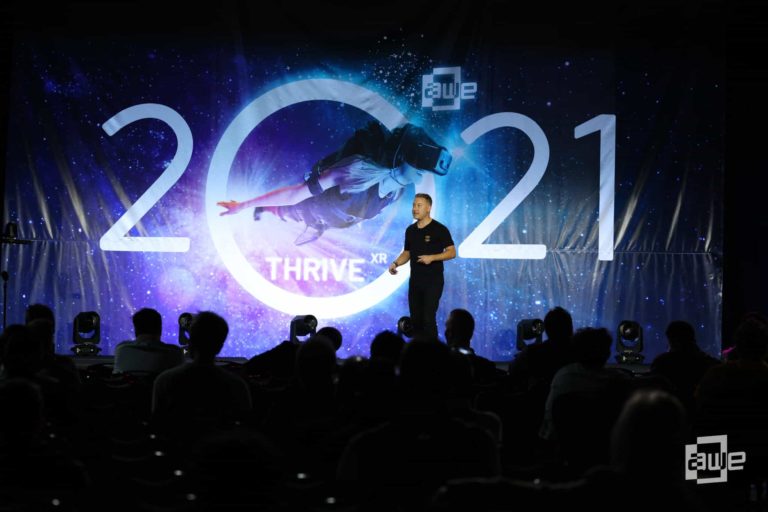
What can the lessons of the past tell us about future outcomes? Specifically within spatial computing, what are applicable lessons from recent tech history? Can the patterns in previous tech revolutions – often with boom & bust cycles – shine a light on what’s ahead in XR?
For example, when looking at the early 2000’s internet bubble, one key lesson was that all the excitement wasn’t wrong… it was just early? All those high-flying predictions and forecasts ended up coming true, but not until the following decade. Could AR and VR be the same?
These and other historical insights were the focus of an AWE presentation from thought leader and 8th Wall VP of Product, Tom Emrich. Following our coverage of his annual predictions, we’re completing the one-two punch with his AWE presentation breakdown for this week’s XR Talks.
The Next Leg
Starting at a high level, Emrich asserts that AR, VR (and what we’re all calling the metaverse) are the next leg of a technological journey that’s been underway for decades. That progression is linear in terms of being part of the same evolutionary arc, but also cyclical in its patterns.
The most insight can be gained from the past few such cycles: the PC and mobile computing. They’re the most recent ones after all. Breaking down the lessons from these periods, Emrich delineates four main categories: terminology, hardware, platforms/content, and culture.
Starting with terminology, it evolves over time and does so organically. The lesson there is don’t get too hung up on the wording as it will take a life of its own (notice how we don’t say ‘cyberspace’ anymore). Terms are also shortened over time (think: web, net, etc.).
There’s also something to be said for the fact that the leaders are sometimes synonymous with a given technology. Sort of like the Kleenex and Ziploc of the tech world, we’re talking about Google (which has become a verb) and iPhone (which has become an icon).
Pattern of Origin
Moving on to hardware, it similarly defines tech revolutions, as it’s the physical symbol of a given era. It also typically arrives first, before software comes along to further define use cases and killer apps. This was the case with the PC and the smartphone. They’re the centerpiece.
Hardware also follows a pattern of origin from academia to military to enterprise to consumer markets. That’s the internet’s progression in a nutshell. But it doesn’t always happen that way. For example, the smartphone followed a consumer-first path, or at least the iPhone did.
There are other common progressions in hardware: Devices miniaturize over time, especially those with chip-based processing – a product and principle of Moore’s Law. Hardware also drives supporting technologies in the value chain, such as connectivity… from 2G to 5G.
The same can be said for operating systems. Hardware drives the need for purpose-built platforms to power them. To again use the iPhone as an example, it gave birth to iOS, which became the nucleus of Apple’s multi-device ecosystem of iThings, including SDKs like ARKit.
Further up the Stack
That brings us to content, which sits further up the stack from hardware and platforms. This is where the rubber meets the road so to speak, as it’s the direct user touchpoint. And the most success historically comes from native design, and avoiding legacy thinking.
This is easier said than done for large companies with value tied up in legacy products. This is the innovator’s dilemma, and is why tech revolutions often germinate new companies that aren’t held back by it. There are exceptions, such as Microsoft’s adaptation to cloud/SaaS.
So who will be the leaders born into the spatial era? And will they have an advantage over the Googles and Metas of the world? It’s been argued that these companies are too big to fail. Incumbents of their size didn’t exist when they themselves first rose to power in past eras.
Either way, the concept rings true that native thinking wins tech revolutions. But it’s not just about new tech alone, as it rarely replaces previous technologies altogether. Though the world is run by iPhones, we still use PCs. The same will likely happen in a prospective XR shift.
Cultural Contracts
Lastly, culture is the x-factor says Emrich. It provides a model for demand-led innovation. This is an intimidating reality because culture can be a moving target, and quite fickle. No matter how advanced a given technology is, it’s dead on arrival if it’s not accepted culturally.
This is precisely the challenge that AR and VR have faced over the past decade. But coming full circle to the dot-com boom/bust cycle, it could just be that these technologies just need more time in the oven. That goes for the technology itself, as well as for cultural readiness.
The lesson for tech companies is to not drink the Kool-Aid nor “read your own press releases.” Make sure the technology passes the grandmother test (think: iPad). And make sure that it works towards sustainable cultural contracts. Only then will spatial computing truly arrive.

